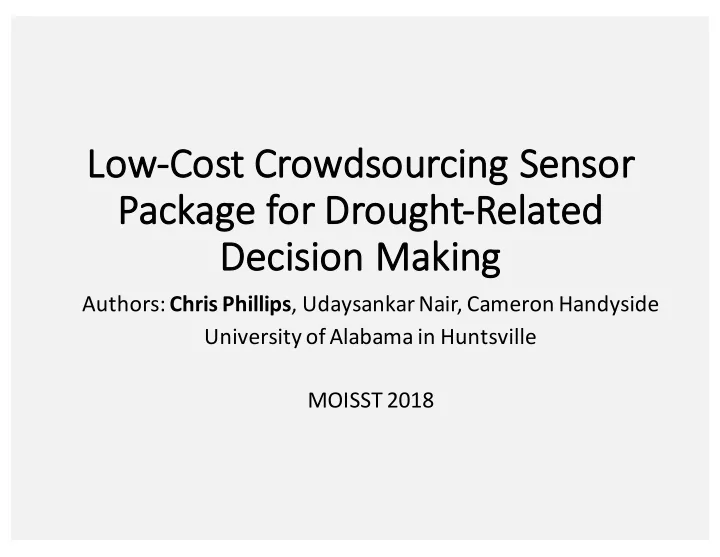

Lo Low-Co Cost Cr Crowdsourcing Sensor Pa Package for Drought-Re Related De Decision Making Authors: Chris Phillips , UdaysankarNair, Cameron Handyside University of Alabama in Huntsville MOISST 2018
Motivation • Drought-related decision making requires knowledge of crop stress, rainfall and soil moisture • Soil moisture monitoring networks are sparse, for example the State of Alabama has ~16 soil moisture monitoring sites • Satellite soil moisture retrievals are limited to 35-60 km resolution. https://www.wcc.nrcs.usda.gov
Motivation • Advent of inexpensive microprocessors systems and sensors presents opportunity for crowdsourcing of rainfall, soil moisture and soil temperature observations (left) Arduino Mini. (right) SHT75 (bottom) Raspberry Pi • We examined the feasibility of developing inexpensive sensor nodes that monitor these variables and integrate the observations into mobile applications that assist decision makers
01.&")(0<&'1=(>;1);-1#
Soil Temperature Sensor- DS18B20 Soil temperature sensor is constructed • from one wire digital temperature sensor DS18B20. Sensor is soldered to a 3 wire cable and • each lead of the chip is insulated heat shrink tubing. The sensor is then placed within copper • tubing and the other side of the tube is hammered to make it water proof. The end of the tube where the chip is • inserted is water proofed using silicone and then enclosed within heat shrink tubing (Cost ~ $5)
Rainfall - Argent Data System Tipping Bucket Rain Gauge COTS sensor, with 0.011 inch resolution (Cost ~$11). • Tips are sensed as switch activation and counted by the Pi •
Design – Gypsum Sensor • Gypsum blocks moisture content in equilibrium with surrounding soil. • Measure voltage across probes and convert to resistance. • Resistance of gypsum block inversely proportional to soil water content. • Sensitivity greatest in dry soil conditions such as during drought. (top) Gypsum mold. (bottom) Gypsum sensor.
Design – Gypsum Block Calibration Resistance of gypsum block is both a function of temperature and moisture. • Following Keyhani (2000), resistance of the gypsum block for standard temperature & ' of 15 0 C: 𝑆 "# = ( ) & ' *( + ,*( - , where 𝐿 " , 𝐿 / and 𝐿 0 are constants, 𝑆 "# and 𝑆 , are resistances at 15 0 C and arbitrary temperature of T 0 C respectively. The constants 𝐿 " , 𝐿 / and 𝐿 0 can be determined using six resistance measurements • made for constant soil moisture conditions. Three of these measurements are made at temperature of 15 0 C and the other three for a differing temperature. A system of linear equations may be used to solve for 𝐿 " , 𝐿 / and 𝐿 0 ;< , where the constant 𝑏 is Volumetric soil moisture is given by 𝑋 = 𝑏𝑆 "# • dependent on soil type and 𝑐 ~ 0.156
Design - Station • The Raspberry Pi ($35) and sensor circuity are placed in a hinged NEMA enclosure ($10) and cables are routed through a waterproof cable gland ($3). • System connects to internet using WiFi and periodically uploads data to Amazon Cloud Soil Moisture Station Services
%"=@3)-&".('"(>I&1);3'-".&(5)"=( 9",39(0%FJ(0'3'-".(J";1=I1)(DEAK
Network Soil Climate Analysis Network (SCAN) hosts • 16 stations in Alabama. Our preliminary goal is 30+ stations across • Alabama. Currently have six near Huntsville. • 30 stations cost less than $4000 • (~$130 per station). Commercial soil monitoring stations are • more than $200 each. Locations of SCAN network soil stations.
C)"3*1)(L=@3,'&($ %"993I")3'-". ! P+"'1)"0&/7-5/'&-X;9;-9&#"'(')"2- P"),/.'/#1-S)0)+".&-+1,-J"+10/'/#1- K9P#SJN-L)1')" ! ^1')%"+'/#1-/1'#-,"#$%&'- 2#1/'#"-,+'+-0'")+2 ! ^1.*$0/#1-/1-X;9;-_!"#$%&'- ^16#"2+'/#1-9$77#"'),-<E- L/'/Z)1-9./)1'/0'0`-K!^9L9N- 02+"'7)- +77D
Broader Impacts - DISCS • App developed by NASA SPoRT • Available for iOS and Android. • Crowd-sources agricultural monitoring • Dissemination of drought related observations such as cumulative rainfall and soil moisture. • Capability to link station data feeds for public viewing.
Broader Impacts - Outreach (left) Student creating soil moisture sensor. (bottom) Students posing with finished sensors. (right) University outreach program to local schools.
Broader Impacts - Outreach • Public availability of NASA DISCS app increases outreach opportunities at local schools. • Students have ability to monitor their station in real-time. • Tie-ins with physical science education • Opportunity to measure hydrological cycle components such as rainfall and soil storage to deduce runoff. • Multiple sensor attachment points allow for experimentation with soil cover. Does bare soil or vegetation produce more runoff? • Ability to see other schools’ stations emphasizes science as a team effort. • Hands-on learning enhances skills that bring the student to a STEM career.
Conclusions • Low cost sensor nodes for soil moisture monitoring have been developed. • Initial results show ability of sensor nodes to realistically capture soil moisture drying trends • The system is automated and the data is available operationally though decision support tools • Due to low costs, it is possible to construct high density networks • The network is being utilized for STEM education in schools.
Acknowledgements • NASA SPoRT Center • UAH Systems Management and Production Center • Funded under NASA Citizen Science for Earth Systems Program
Recommend
More recommend